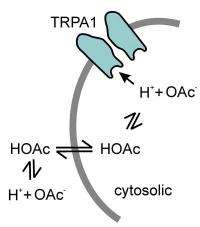Researchers explain how animals sense potentially harmful acids

All animals face the challenge of deciding which chemicals in the environment are useful and which are harmful. A new study greatly improves our understanding of how animals sense an important class of potentially harmful chemicals: weak acids. The study appears online on May 16 in the Journal of General Physiology.
Weak acids like acetic acid (vinegar) and propionic acid (present in fermented foods like Swiss cheese) are shunned by many animals, and with good reason. Many organic acids in the environment can have widespread detrimental effects. Humans ingest these substances despite the fact that they actually elicit "irritating" sensations, a physiological response that may have been vital for our ancestors' survival.
So what are the molecular sensors and mechanisms involved when animals detect these substances? Although researchers have identified sensors for many harmful chemicals, the mechanisms involved in the detection of weak acids have been a mystery. Now, University of Southern California researcher Emily Liman and colleagues identify the sensor as none other than the ion channel TRPA1. The authors show that TRPA1 responds to weak acids when they acidify the cytoplasm within the cell. Such cytoplasmic acidification can have very negative consequences—even triggering cell death—which explains why this process raises such alarm bells in animals.
Researchers have been surprised in recent years to discover how many different types of noxious stimuli can be sensed by TRPA1, explains Brandeis University's Paul Garrity in a Commentary accompanying the study. With this latest research, weak acids can be added to that growing list.
More information:
Garrity, P.A. 2011. J. Gen. Physiol. doi:10.1085/jgp.201110657
Wang, Y.Y., et al. 2011. J. Gen. Physiol. doi:10.1085/jgp.201110615
















